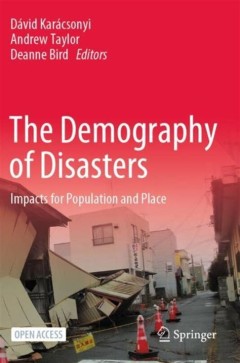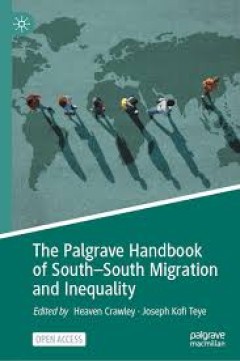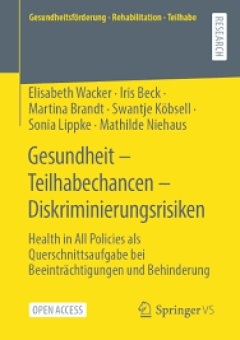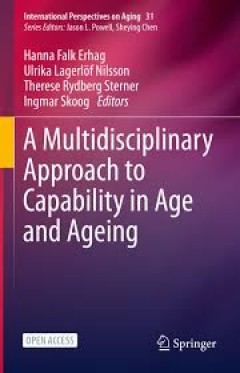Filter by

Ageing in Europe. Supporting Policies for an Inclusive Society
SHARE is an international survey designed to answer the societal challenges that face us due to rapid population ageing. How do we Europeans age? How will we do economically, socially and healthwise? How are these domains interrelated? The authors of this multidisciplinary book have taken a further big step towards answering these questions based on the recent SHARE data in order to support pol…
- Edition
- -
- ISBN/ISSN
- 9783110444414
- Collation
- xii, 380
- Series Title
- -
- Call Number
- -

Wohnen in Gesundheit = Die Corona-Pandemie und Teilhabe in besonderen Wohnfor…
In diesem Open-Access-Buch wird die Coronapandemie in besonderen Wohneinrichtungen der Eingliederungshilfe im sozialwissenschaftlichen Blick erfasst. Die Lagebeschreibung spiegelt verschiedene Perspektiven: die Einschätzungen von Menschen mit Beeinträchtigungen, Leitungsverantwortlichen, Fachpersonal und Angehörigen. Die Daten wurden bundesweit während der Lockdown-Phasen in einer qualitati…
- Edition
- -
- ISBN/ISSN
- 9783658464523
- Collation
- XXVII, 206 hlm; ill., lamp.,
- Series Title
- -
- Call Number
- -

Pflegefachpersonen als pflegende Angehörige
In diesem Open-Access-Buch stehen Pflegefachpersonen im Zentrum, die zugleich pflegende Angehörige sind. Als professionell Pflegende verfügen sie über Fachwissen, pflegefachliche Kompetenzen und Kenntnisse zum Versorgungssystem. Als pflegende Angehörige sind sie persönlich betroffen. Die qualitative Studie fokussiert auf das Erleben der Doppelrolle als beruflich Pflegende und zugleich pfle…
- Edition
- 1
- ISBN/ISSN
- 978-3-658-40972-2
- Collation
- XV, 127
- Series Title
- -
- Call Number
- -

The Demography of Disasters = Impacts for Population and Place
This open access book provides worldwide examples demonstrating the importance of the interplay between demography and disasters in regions and spatially. It marks an advance in practical and theoretical insights for understanding the role of demography in planning for and mitigating impacts from disasters in developed nations. Both slow onset (like the of loss polar ice from climate change) a…
- Edition
- 1
- ISBN/ISSN
- 9783030499204
- Collation
- XVII, 268 ill; lamp
- Series Title
- -
- Call Number
- -

Cohabitation and Marriage in the Americas: Geo-historical Legacies and New Tr…
This open access book presents an innovative study of the rise of unmarried cohabitation in the Americas, from Canada to Argentina. Using an extensive sample of individual census data for nearly all countries on the continent, it offers a cross-national, comparative view of this recent demographic trend and its impact on the family. The book offers a tour of the historical legacies and regional…
- Edition
- 1
- ISBN/ISSN
- 978-3-319-31442-6
- Collation
- oer.unej.ac.id
- Series Title
- -
- Call Number
- XXV, 291

The Palgrave Handbook of South–South Migration and Inequality
This open access handbook examines the phenomenon of South-South migration and its relationship to inequality in the Global South, where at least a third of all international migration takes place. Drawing on contributions from nearly 70 leading migration scholars, mainly from the Global South, the handbook challenges dominant conceptualisations of migration, offering new perspectives and insig…
- Edition
- -
- ISBN/ISSN
- 9783031398148
- Collation
- XXXVIII, 749
- Series Title
- -
- Call Number
- -

Alterung und Pflege als kommunale Aufgabe : Deutsche und japanische Ansätze …
Die Beiträge in diesem Open-Access-Sammelband beschreiben und analysieren aus multidisziplinärer Sicht die Herausforderungen und Bewältigungsstrategien von Alterung und Pflege in japanischen und deutschen Gemeinden. Thematisiert werden rechtliche Rahmenbedingungen, zivilgesellschaftliches Engagement, Pflegekräftemangel, Technologiekonzepte für die Pflege und schließlich auch der Einfluss …
- Edition
- -
- ISBN/ISSN
- 978-3-658-36844-9
- Collation
- XV, 364
- Series Title
- Dortmunder Beiträge zur Sozialforschung (SOZF)
- Call Number
- -

Migration Diversity and Social Cohesion : Reassessing the Dutch Policy Agenda
This open access book shows policymakers which initiatives work when responding to the increasing diversity in cities, towns and neighborhood's. In recent times, policymakers have grappled with ways of responding to this increase, which has resulted in a plethora of policy initiatives, some more effective than others. Bringing together a large amount of research and evidence-based policy recomm…
- Edition
- 1
- ISBN/ISSN
- 9783031142246
- Collation
- XIII, 187 hlm,: ill, lamp;
- Series Title
- -
- Call Number
- -

Gesundheit – Teilhabechancen – Diskriminierungsrisiken : Health in All Po…
Das Recht auf Gesundheit und Wohlergehen steht allen Menschen zu, unabhängig von Alter, Geschlecht, Beeinträchtigung oder anderen Vielfaltsmerkmalen. Auf die enge Verknüpfung von gesellschaftlicher Teilhabe und bestmöglicher Gesundheit macht das Gemeinschaftswerk aufmerksam. Es weist auf Exklusions- und Isolationsrisiken hin, zeigt Erfahrungen aus der Coronapandemie auf und öffnet Wege, um…
- Edition
- -
- ISBN/ISSN
- 978-3-658-40760-5
- Collation
- XVII, 208
- Series Title
- Gesundheitsförderung - Rehabilitation - Teilhabe (GRT)
- Call Number
- -

A Multidisciplinary Approach to Capability in Age and Ageing
This open access book provides insight on how to interpret capability in ageing – one’s individual ability to perform actions in order to reach goals one has reason to value – from a multidisciplinary approach. With for the first time in history there being more people in the world aged 60 years and over than there are children below the age of 5, the book describes this demographic trend…
- Edition
- -
- ISBN/ISSN
- 978-3-030-78063-0
- Collation
- XIV, 252
- Series Title
- International Perspectives on Aging (Int. Perspect. Aging, volume 31)
- Call Number
- -
 Computer Science, Information & General Works
Computer Science, Information & General Works  Philosophy & Psychology
Philosophy & Psychology  Religion
Religion  Social Sciences
Social Sciences  Language
Language  Pure Science
Pure Science  Applied Sciences
Applied Sciences  Art & Recreation
Art & Recreation  Literature
Literature  History & Geography
History & Geography